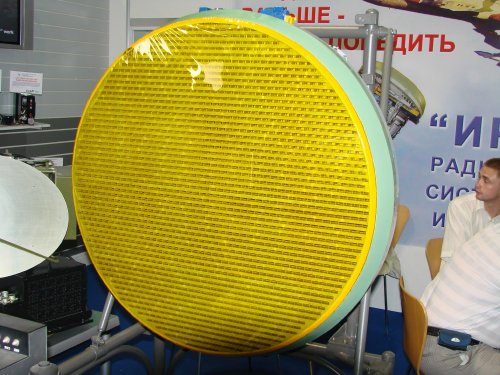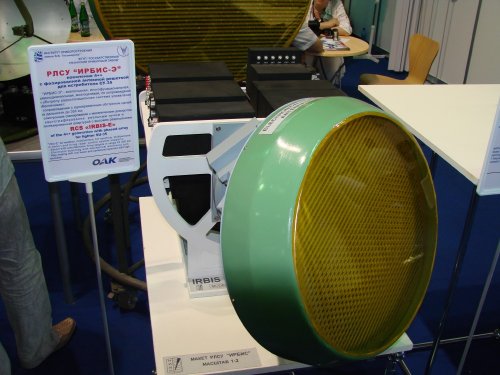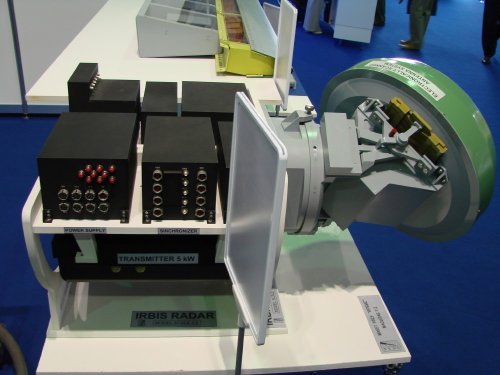- Joined
- 27 December 2005
- Messages
- 16,924
- Reaction score
- 21,798
New details about [RLSU] “Irbis” for the fighter Su-35
Recently Tikhomirov” NIIP released sufficiently comprehensive information about the developed by it new RLSU (radar system for control) phased antenna array “Irbis”, intended for the application on the new modifications of the fighters of family Su-27 - first of all on the aircraft Su-35 and the modernised fighter Su-27SM2. Last year the enterprise designed advertising book on RLSU “Irbis-E”. which now makes it possible to describe about some design features and possibilities of new radar.
RLSU Irbis, development of which is conducted in NIIP from 2004 under chief designer Vladimir Zagorodniy’s leadership on the basis of the experience of creation RLS with the passive phased arrays “Bars” and Osa”, is intended for the decision in the composition of the integrated complex BREO of the carrier aircraft of the wide circle of tasks by detection and accompaniment of air, ground and surface targets, to the determination of their [gosprinadlezhnosti], to the identification of class [itipa] are air”; targets, to the determination of a quantity of aerial targets in the group, to the forming of the radar trace of the underlying surface (actual chart area) in the modes of low, average and high resolution, to information input of a low-altitude flight with flight around and turning movement of obstacles, correction of navigation systems, to the measurement of distance, to the missile guidance with the radar homing heads ([RGS]), etc.
Structurally [RLSU] “Irbis-E” is multifunctional radar system X band with the passive phased array. Placed on the two-axis hydraulic drive (along the azimuth and bank), with the use of a promising computing system EKVS-E BTsVM “Solo -35”. Antenna system on the base passive phased array with a diameter of 900 mm with the vertical polarisation of wave and the switch time during electronic control 0,4 ms scans with the electronic beam steering along the azimuth and the angle of elevation in the sectors not less than 60°. Furthermore, two-stage electrohydraulic drive mechanically turns antenna in azimuth to the bearing to 60° and in bank to the bearing of 120°. Therefore, the maximum angle of deflection of ray with respect to the azimuth during electronic control and mechanical corrective turn of antenna increases to 120°. In this case the vertical polarisation of wave can be changed to horizontal for a improvement in the conditions of observing the surface targets.
The transmitter, made on the base of the solid-state master oscillator “Oliva” and chains from two traveling-wave power amplifiers of the type “Chelnok”, ensures the maximum peak power at the survey frequencies not less than 20 kW with the average power 5 kW, or the average discrete continuous power of the transfer at frequencies of illumination not less than 2 kW. Four-channel receiver on the base of the low-noise intake amplifier assumes and primarily converts HF-signal with the factor of noise 3.5 dB. Digital processing of the signals accepted it occurs in the programmable signal processor on the base BTsVM “Solo -35.01”, and data processing and control of work [RLSU] - in BTsVM “Solo-35.02”, which together form BTSVS EKVS-E.
With the development RLSU “Irbis-E” is used a number of the already well developed devices from the composition RLSU “Bars”, used on the aircraft Su-30MKI. Their number includes the synchroniser, LF and SHF-receivers, the master oscillator. Two-stage drive EGSP-27 RLSU “Irbis-E” is further development of the single power drive “Bars” - EGSP-6A. The new passive phased array is developed on the basis of technical and tecjnological decisions, approved with the development of “Osa” and “Bars phased arrays”. The amplifier of transmitter is developed on the base of the output amplifier of power on the base of the travelling-wave tube “Chelnok”, created within the framework of the program BRLS N011M (prototype “Bars”) and passed inspection in the composition BREO experimental aircraft Su-27M №712 in the stage of flight design tests, after ensuring a notable increase in the range of system.
RLSU “Irbis-E” can locate and simultaneously track up to 30 aerial targets with the retention of the continuity of the survey of space (track while scan), ensure the simultaneous fire of two targets with two rockets with semi-active RGS and up to eight targets by eight rockets with active RGS, in such cases to four targets at the distance of more than 300 km. In the mode “air-surface” the complex ensures the mapping of land and sea surfaces and the detection of ground targets in the modes of survey with real beam (low resolution) with the Doppler sharpening (medium resolution) and SAR mode (modes of high and superhigh resolution). Range of detection of aerial targets RCS 3 sq m in the head-on courses in RLSU “Irbis-E” comprises not less than 350-400 km, while in the overtaking courses - not less than 150 km (with the height of target 10 km and more). To detect “stealthy” targets RCS 0.01sq m station can at the distances to 90 km. Resolution during the identification of dense multiple target (at a distance of 50 km) it comprises: on the distance - 50-100 m, on the velocity - 5 m/s and on the angular coordinates - 2,5°.
Being the logical development “Bars”, RLSU “Irbis”, thus, has considerably higher characteristics: the extended (more than doubled) zone the working of frequencies, the increased from 70 to 120 deg zone of detection and accompaniment of aerial targets along the azimuth, the considerably increased range, the improved jamming invulnerability, etc through these indices “Irbis” is located on the level of the most up-to-date foreign developments in this region, exceeding the majority of American and West European RLS with the passive and the active phased arrays and practically without being inferior to the most perfect system of this class - RLS AN/APG-77 of American fighters F-22.
Velet (Takeoff) April 2006








